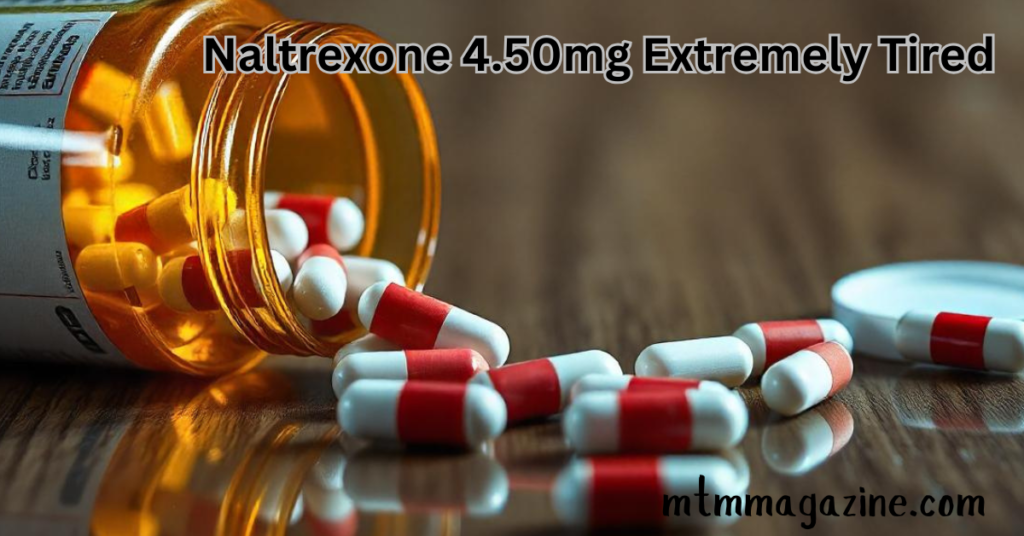Naltrexone, particularly in low doses like 4.50 mg, has gained popularity for its potential benefits in managing autoimmune conditions, chronic pain, and other health issues. However, some people experience extreme tiredness or fatigue when taking it. In this article, we’ll dive into why fatigue might occur with naltrexone, what you can do to manage it, and when to seek further help. Understanding these factors can help you use naltrexone effectively without letting fatigue interfere with your daily life.
What is Naltrexone, and Why is it Prescribed?
Naltrexone is a medication that was originally developed to treat opioid addiction by blocking the effects of opioids. In recent years, low-dose naltrexone (LDN), such as the 4.50 mg dose, has shown promise in managing conditions like fibromyalgia, multiple sclerosis, Crohn’s disease, and chronic fatigue syndrome. The low dose works differently than the higher doses used for addiction; it is believed to help balance the immune system, reduce inflammation, and even improve mood in some people.
However, despite its potential benefits, LDN can sometimes cause side effects, with fatigue being one of the more common complaints, especially during the initial stages of treatment.
Why Does Naltrexone 4.50mg Cause Fatigue?
Fatigue with naltrexone may happen for several reasons:
1. Adjustment Period:
When starting a new medication, the body often needs time to adjust. As naltrexone begins to impact the body’s opioid receptors and immune system, you may feel more tired than usual. This adjustment period usually lasts a few weeks.
2. Impact on Endorphins:
Naltrexone partially blocks opioid receptors, which are linked to the release of endorphins, the body’s natural “feel-good” chemicals. In low doses, naltrexone can help the body produce endorphins, but as the body adapts, it may initially experience a temporary drop in these chemicals, leading to fatigue.

3. Sleep Disturbances:
Naltrexone can interfere with sleep patterns in some individuals. Some report vivid dreams or waking up during the night, which can contribute to daytime fatigue.
4. Underlying Health Conditions:
Many people who take LDN are already dealing with chronic health conditions that can cause fatigue. For example, if someone is managing an autoimmune disease, it’s sometimes difficult to tell if the tiredness is due to the condition itself or a side effect of naltrexone.
Understanding why fatigue may occur with naltrexone helps set realistic expectations and allows users to implement effective strategies to manage this side effect.
Tips for Managing Fatigue While Taking Naltrexone 4.50mg
1. Start Slowly and Adjust Dosage Gradually
- Some people benefit from starting with an even lower dose, such as 1.5 mg, and slowly increasing to 4.50 mg over a few weeks. Gradual dosing may help minimize fatigue as it gives the body more time to adjust to the medication.
2. Take Naltrexone at Night
- Taking naltrexone in the evening or before bed can help reduce daytime fatigue for some individuals. Since it may cause tiredness, taking it at night allows you to rest while the medication is working, potentially avoiding its impact on your daily energy levels.

3. Maintain a Balanced Diet and Stay Hydrated
- Nutrient-rich foods and adequate hydration are essential for energy. Eating a balanced diet that includes lean proteins, whole grains, fruits, and vegetables helps support your body’s energy needs. Avoid excessive caffeine and sugar, as these can cause energy crashes and exacerbate fatigue.
4. Engage in Light Physical Activity
- While it may seem counterintuitive, light physical activity can actually help improve energy levels. Activities like gentle walking, stretching, or yoga can boost circulation, improve mood, and fight fatigue without exhausting the body. Be mindful of your limits, especially if you have a chronic condition, and listen to your body’s signals.
5. Practice Good Sleep Hygiene
- Establishing a consistent sleep routine can help combat fatigue. Avoid screens before bed, create a relaxing bedtime ritual, and keep your sleeping environment dark and quiet. Practicing good sleep hygiene is essential to reduce any naltrexone-induced sleep disturbances.
6. Consider Taking Supplements
- Some people find that certain supplements, like vitamin B12, vitamin D, magnesium, and Coenzyme Q10, can help with fatigue. Speak with your doctor about any supplements you’re considering, as they can assess your needs and ensure there are no interactions with naltrexone or other medications.
7. Monitor Your Body’s Response and Keep a Journal
- Keeping track of your energy levels, diet, sleep, and any other symptoms can help identify patterns related to fatigue. A journal helps you assess whether certain actions (like adjusting your dose timing or engaging in exercise) have a positive impact.
When to Talk to Your Doctor
If the fatigue persists or worsens despite these strategies, it’s a good idea to talk to your doctor. They may suggest a lower dose, a gradual dose increase, or an alternative timing for taking the medication. In some cases, extreme tiredness could indicate that naltrexone is not the right fit for you, or it might interact with another medication or condition.

Is Naltrexone Fatigue Permanent?
For many people, fatigue caused by naltrexone tends to diminish over time as the body adjusts to the medication. Typically, within a few weeks to a few months, users find that their energy levels return to normal. However, for others, fatigue can be a longer-term side effect, and alternative treatments may be worth exploring if it interferes significantly with daily life.
Conclusion
Low-dose naltrexone at 4.50 mg can be highly beneficial for various health conditions, but it may come with the side effect of fatigue, especially during the initial phase of treatment. By understanding why this fatigue occurs and implementing strategies to manage it—like adjusting the dose, maintaining good sleep hygiene, staying active, and consulting your doctor—you can reduce the impact of tiredness and better enjoy the benefits of the medication.
While fatigue may not completely disappear for everyone, it’s often a temporary side effect, and many people find relief with a few adjustments and patience as their bodies adapt to the medication. Always remember that personalized medical advice from your doctor is key to safely managing any side effects.



